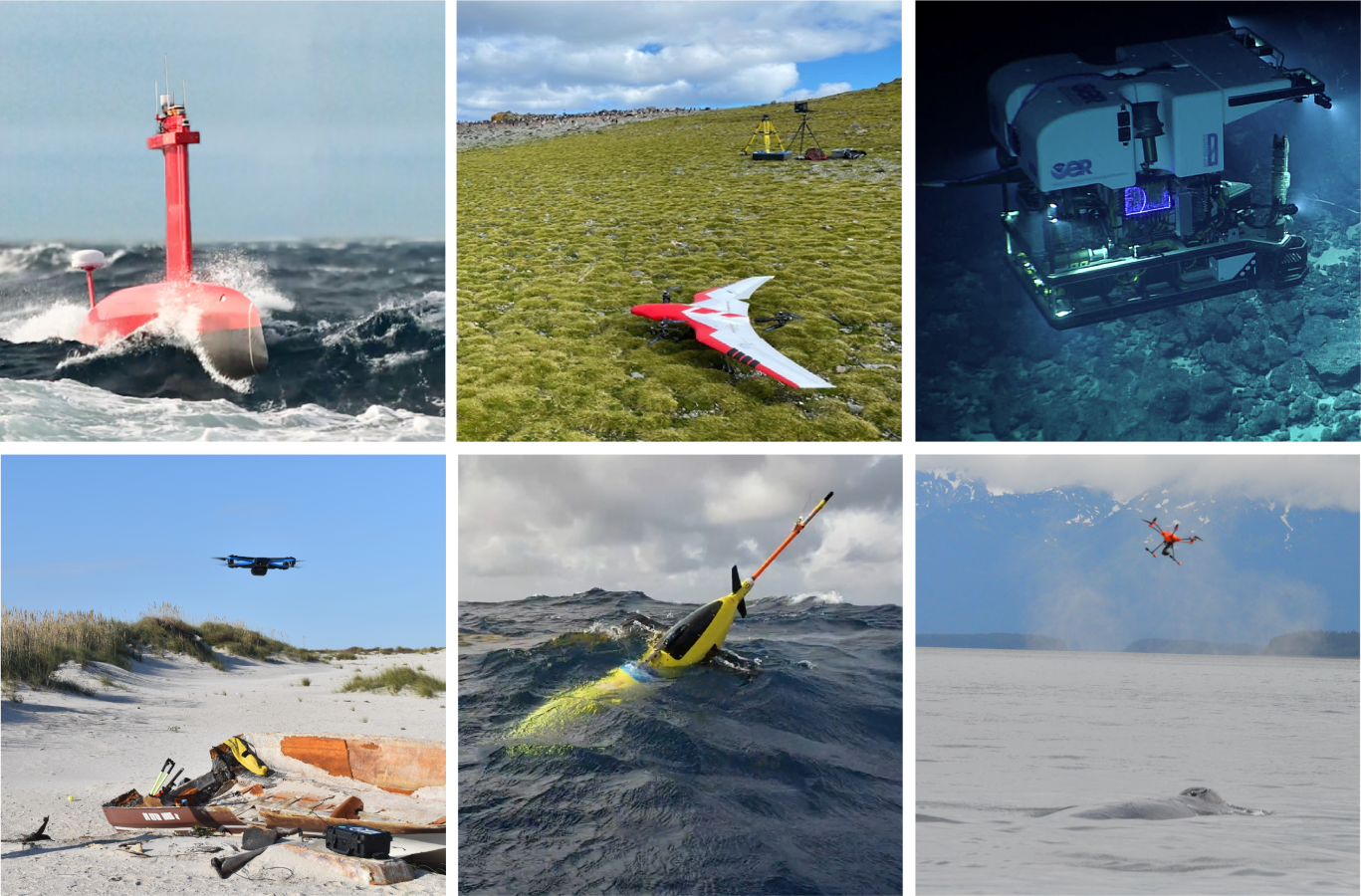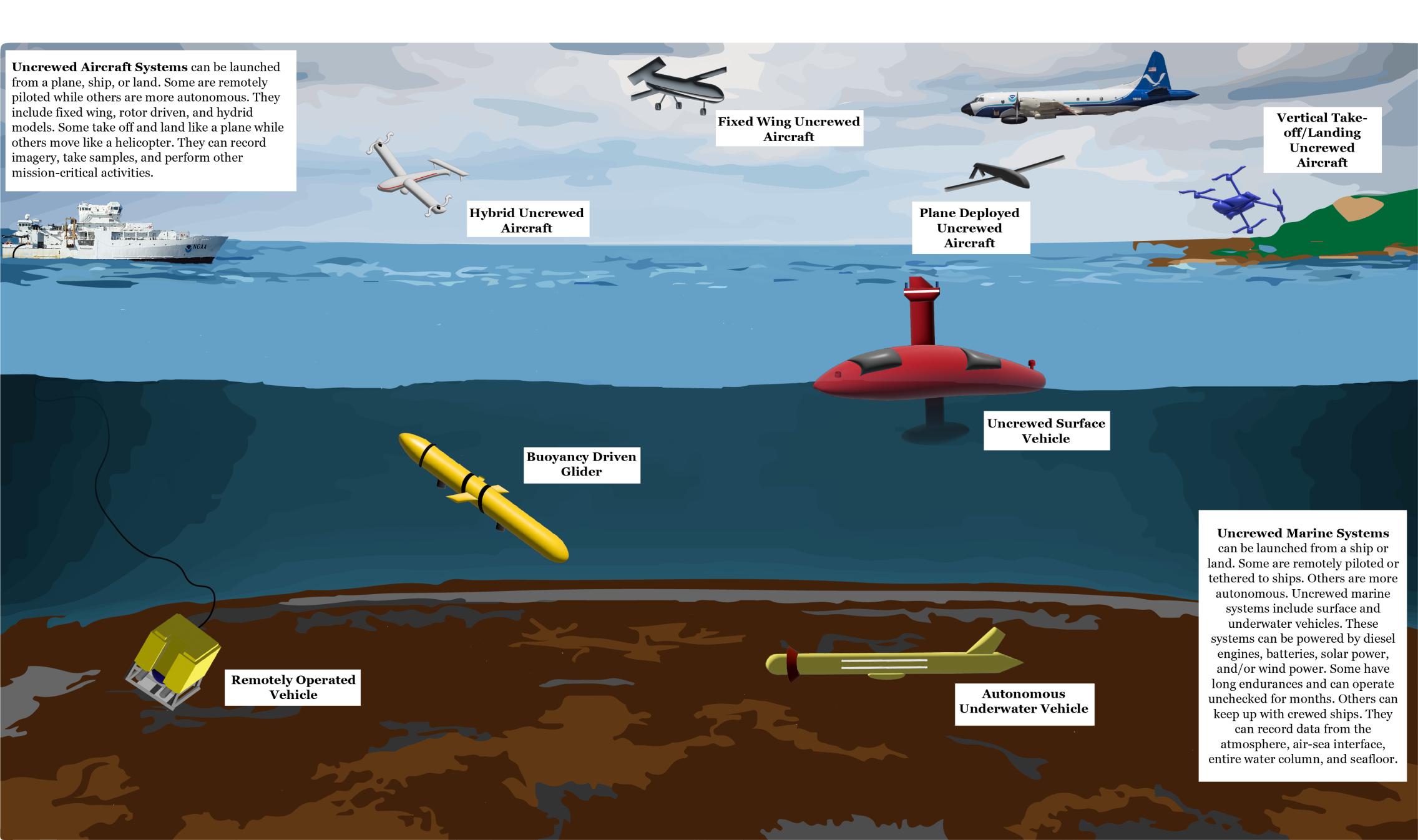
Uncrewed aircraft and marine systems are playing a growing role in how NOAA collects data. Collectively known as uncrewed systems (UxS), they are expanding the collection and utilization of critical, high accuracy, and time-sensitive data and are enhancing the way NOAA meets its mission requirements in almost all of its mission areas.
The recent rapid expansion in availability of UxS, fueled in part by NOAA scientists and discoveries, has brought a corresponding increase in their innovative use as a force multiplier for many NOAA programs—augmenting data collection often at lower cost, increased safety, and reduced risk, especially in remote or extreme environments. Examples include hydrographic and habitat mapping, ocean exploration, marine mammal and fishery stock assessments, emergency response, including tornado damage assessments, and at-sea observations that improve forecasting of extreme events, such as hurricanes, harmful algal blooms and hypoxia.
NOAA received funding from Congress in Fiscal Year 2020 to improve and expand UxS operations across the agency, including the creation of an Uncrewed Systems Operations Center (UxSOC). Part of the NOAA Office of Marine and Aviation Operations (OMAO), the UxSOC helps meet the objectives of the Commercial Engagement Through Ocean Technology Act of 2018, which requires NOAA to coordinate research, assess and acquire uncrewed marine systems (UMS) with the U.S. Navy, other federal agencies, industry and academia.
The UxSOC is at the forefront of NOAA’s efforts to capitalize on the promise of UxS. Its objectives are:
-
Development, Transition, and Innovation
-
Fund research, development, testing, and evaluation of UxS projects to explore new capabilities and mission applications, and transition technologies to regular operations
-
Assess UxS capabilities in relation to NOAA requirements
-
Measurably increase reliability, capacity, efficiency, and safety of NOAA UxS missions
-
-
Operations and Support
-
Operationalize UxS corporate assets for use across NOAA missions, or establish other operating models (i.e., industry operated) where fiscally appropriate
-
Provide UxS expertise and associated services
-
-
UxS Leadership and Collaboration
-
Inform, coordinate, and implement UxS policies, authorities, and positions
-
Coordinate and collaborate within NOAA and with industry, academia, government, and NGOs
-
-
Model Workplace
-
Recruit and develop an expert workforce empowered by a strong culture and infrastructure
-
Learn more about these objectives in the UxSOC Strategic Plan (2024-2028). To accomplish these objectives, the UxSOC has a UAS Division, co-located with NOAA’s Aircraft Operations Center in Lakeland, Florida, and a UMS Division based in Gulfport, Mississippi.
What are uncrewed systems?
Uncrewed systems are vehicles that can operate without a person onboard. They are typically controllable or programmable. Some can operate fully autonomously, or without the oversight of anyone. Others require remote guidance from a person. That can be someone piloting remotely in real-time, a pre-programmed path or task, or other oversight by a person.
NOAA divides its UxS by the main environments they operate in – the air (Uncrewed Aircraft Systems, or UAS), and the water (Uncrewed Marine Systems, or UMS). Within these categories, there are many types of UxS that vary based on the task they are meant to complete.
UxS vary in size (some are the size of carry-on luggage to allow for portability while others are the length of a tractor trailer), power source (some are solar powered, rechargeable, or diesel powered), speed (some can move faster than a crewed ship or plane), tasks they can perform, and other features.

How does NOAA use uncrewed systems?
Uncrewed systems are used across the agency as tools to gather data to support NOAA’s mission areas. UxS serve as force multipliers, enhancing traditional data collection methods and allowing data collection in unobserved and minimally observed regions. NOAA uses UxS to increase productivity, safety, and longevity of its research efforts.
NOAA also works to develop new forms of UxS for different mission applications. This work can range from early stage research on a new technology to evaluation of a UxS to meet a NOAA mission, with the potential to transition it into routine use.
For example, NOAA uses UxS to sample the upper limits of the atmosphere, at the air-sea boundary, and in the depths of the ocean. They have also been used from the Arctic to Antarctic, and across the United States. In the upper limits of the atmosphere, uncrewed aircraft systems (UAS) allow scientists to take air measurements where planes cannot fly. At the air-sea boundary, UxS augment pre-existing data gathering tools, like buoys. They also provide data in portions of the air-sea boundary that are hard to sample, like within a hurricane. In the depths of the ocean uncrewed marine systems (UMS) are historically used to map, characterize, and explore the seafloor. As people change the ocean landscape UxS also allow NOAA to observe the depths of the ocean in new ways. For example, UMS can maneuver around manmade structures (like wind turbines) or detect manufactured objects (like sunken ships and marine debris).
By deploying UxS in these diverse environments NOAA can better meet its mission of science, service, and stewardship. Keep reading to learn more about how NOAA uses UxS to support its science, service, and stewardship efforts.
UxS in Support of Science
- NOAA developed sensor payloads for uncrewed aircraft that can measure aerosols and assess clouds.
- NOAA uses underwater gliders to observe and monitor marine life and ecosystems.
UxS in Support of Service
- NOAA uses uncrewed aircraft to survey tornado paths and inform more effective community response and recovery efforts in remote areas.
- NOAA uses uncrewed surface vehicles to map the ocean and create nautical charts and other navigation tools.
UxS in Support of Stewardship
- NOAA uses uncrewed aircraft systems and uncrewed surface vehicles to manage human activity, marine life, and other features within National Marine Sanctuaries and marine protected areas.
- NOAA uses uncrewed marine systems to assess and manage fish stocks and other living marine resources.
United States

